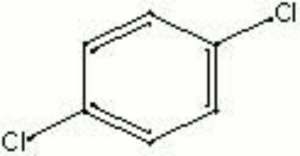Paradichlorobenzene
Description
White crystals that sublime at room temperature producing the characteristic odor of mothballs. Paradichlorobenzene (PDB) is used as an insecticidal fumigant in closed area. It kills insects and larvae but not eggs and thus will not prevent reinfestation. PDB can soften some plastics (Cellulose nitrate, Polyvinyl acetate, Styrofoam®) and may damage feathers, leather, and bronze (Zycherman and Schrock, 1988). It can also affect paper, Zinc white, Lithopone, ultramarine blue, scarlet pigments, inks and cellulose acetate dyes. While PDB is listed as noncorrosive, it has the potential of degrading to form chlorine gas.
Synonyms and Related Terms
p-dichlorobenzene; PDB; PDCB; 1,4-dichlorobenzene; Paracide; Paramoth; Di-Chloride; Paradow; Santochlor [Solutia]; Para-Di; mothball
Risks
- Irritating to eyes, skin and nasal passages.
- Toxic by ingestion, inhalation and contact.
- Causes headaches, nausea, liver and kidney damage as well as narcosis.
- Suspected carcinogen.
- Combustible. Flash point = 66 C (151 F)
- Fisher Scientific: MSDS
Physical and Chemical Properties
Soluble in ethanol, ether, benzene, chloroform, carbon disulfide. Insoluble in water.
| Composition | C4H6Cl2 |
|---|---|
| CAS | 106-46-7 |
| Melting Point | 53-54 C |
| Density | 1.458 g/ml |
| Molecular Weight | mol. wt.=147.01 |
| Boiling Point | 174.12 C |
Resources and Citations
- L. Zycherman, J.R. Schrock, A Guide to Museum Pest Control, FAIC, Washington, DC, 1988. ° J.Dawson, "Solving Museum Insect Problems: Chemical Control", CCI Technical Bulletin No. 15.
- J. Dawson, CCI Technical Bulletin, 'Solving Museum Insect Problems: Chemical Control' , Canadian Conservation Institute, Ottawa, No. 15
- Lynda A. Zycherman, J.Richard Schrock, A Guide to Museum Pest Control, FAIC and Association of Systematics Collections, Washington DC, 1988
- Marjorie Shelley, The Care and Handling of Art Objects, The Metropolitan Museum, New York, 1987
- Stephen R. Edwards, Bruce M. Bell, Mary Elizabeth King, Pest Control in Museums: a Status Report 1980, Association of Sytematics Collections, Washington DC, 1980
- Michael McCann, Artist Beware, Watson-Guptill Publications, New York City, 1979 Comment: flash point = 165F (74C)
- Pam Hatchfield, Pollutants in the Museum Environment, Archetype Press, London, 2002
